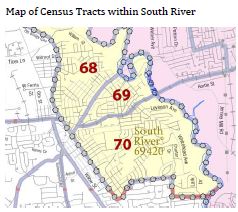Your Town: Flooding, Neighborhood Change, Resilience, and Health
Article by Magdalena Mysliwiec, Rutgers graduate studio participant
Standing at Pacers Field in flood-prone South River, NJ, alongside locals kind enough to give a tour of the town, the Spring 2020 Rutgers University Environmental Planning Studio team, made up of seven graduate students and partnered with the nonprofit Lower Raritan Watershed Partnership, got their first peek of the water which flows through this community. Seeing and hearing the stories and concerns of the hometown tour guides about the South River was the team’s introduction to learning how a community’s relationship with its water systems affects the neighborhood, from the people who live there and their health, to the buildings they live and work in. It is a relationship all towns in New Jersey are familiar with and all towns benefit from.

The studio team spent their semester studying South River, the people who live there, its housing, and water, including the water that begins outside South River in other parts of New Jersey and then flows into the town. They focused their attention on South River’s Census Tract 69 area (seen in the map below) where life expectancy is the lowest in Middlesex County. The team’s research also prepares South River for participation in a New Jersey Department of Environmental Protection (NJDEP) project to build up the town’s resilience (or, ability to recover) from future extreme weather events like flooding.

As a result of the life expectancy issues in Census Tract 69, the studio team identified a goal of achieving equal health outcomes for all residents of the multi-cultural South River. Three categories of issues South River must tackle were identified by the team: regional planning, design, and community development and are described in the attached one-page document, found below in both English and in Spanish. Importantly, solutions to the issues require partnerships, including with South River residents themselves. For example, the town government and agencies will need to take the next steps of involving locals of all cultural backgrounds in the town’s resilience decisions. This means being creative with outreach to the community, such as by hosting cultural events where locals can comfortably share their opinions on town decisions, or by sharing newsletters like this one in both English and Spanish. More proposals and recommendations can be found in the studio team’s final report, which is linked to in the list of resources below.
The studio team also recorded South River’s “Water Story” using the Water Story tool from the non-profit Sustainable Jersey. This tool guides municipalities through the collection of data needed to create a borough-specific narrative of water. Water is a human right every person should be able to access. People use water for different daily tasks like drinking, cooking, and cleaning. Where water is stored and treated, and the management of water, are important for a healthy life. Understanding a municipality’s Water Story is also increasingly important in the context of extreme weather events, which threaten utilities and other facilities that produce drinking water and treat wastewater (or, used and contaminated water) for South River and other New Jersey towns.
The Water Story tool builds understanding of South River’s water infrastructure and resources, in addition to highlighting local water issues and actions to turn water into an asset for all residents of the town. The identified issues are based on data from local, county, and state resources on water supply, wastewater, and stormwater as well as from speaking with South River Green Team members and the Mayor. The issues are listed on page 84 of the final report.
Short-term next steps of the South River studio project are more community outreach and engagement to ensure that every townsperson can be involved with the Borough’s resilience decisions. These actions will be led by the Lower Raritan Watershed Partnership, the South River Green Team, and the Middlesex County Office of Planning. More resources are listed below for residents looking to take part in “citizen science” and explore their waterways on their own, and take the initiative to make New Jersey’s water an asset for everyone.
RESOURCES:
Watershed Explorer mapping tool
Environmental Justice screening and mapping tool
